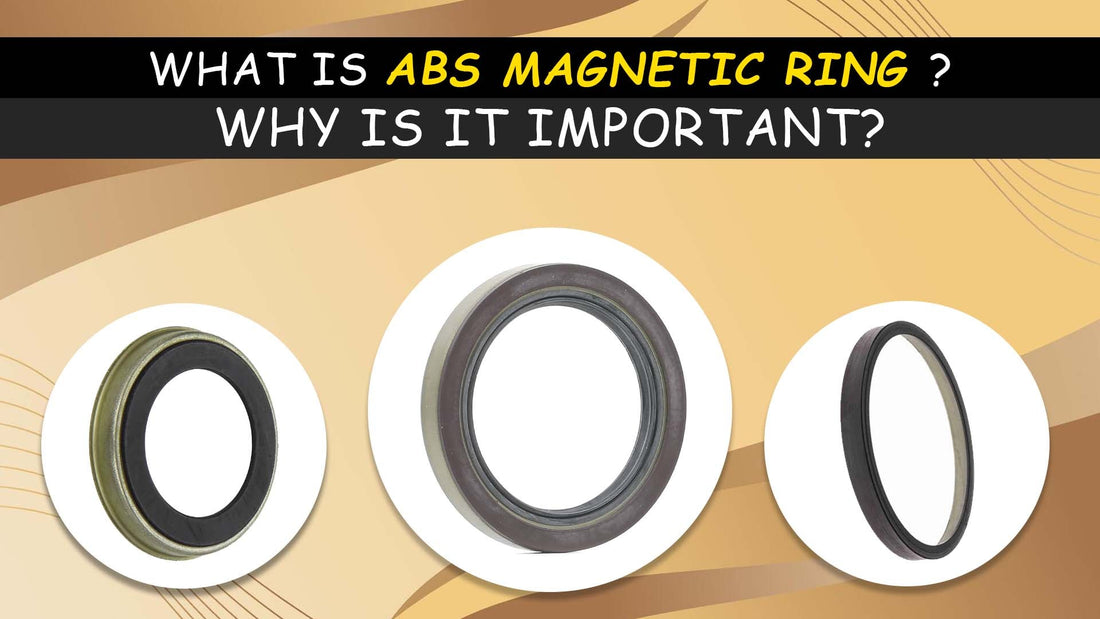
Beyond the Cog: Understanding ABS Magnetic Rings and Their Crucial Role

We’ve all experienced the reassuring pulse of the Anti-lock Braking System (ABS) kicking in during a hard stop. It’s a safety feature we often take for granted, but beneath the surface lies a network of components working in perfect harmony. While the toothed “reluctor ring” (or tone ring) is a common sight, there's another key player in this process that deserves a closer look: the ABS magnetic ring. It’s a subtle difference but one that has significant implications for how ABS systems function in modern vehicles. Let's delve into the world of these often-overlooked magnetic components.
What is an ABS Magnetic Ring and Why is it Different?
Unlike the toothed reluctor ring, which relies on disruptions in a magnetic field caused by its physical teeth, a magnetic ring uses a different approach. It's typically a flexible, circular band embedded with alternating north and south poles, creating a complex magnetic pattern. Think of it like a magnetic barcode that encodes wheel speed information. This band is usually mounted on the wheel hub, bearing assembly, or drive shaft, very similar to the conventional reluctor ring.
The Magnetic Field: A More Subtle Approach

Image By Actronics
The ABS sensor, strategically placed near this magnetic ring, doesn’t need the physical teeth to induce a signal. Instead, it detects the changing magnetic field as the ring rotates. Each time a north or south pole passes by, the sensor generates a unique electrical signal. The frequency of these signals directly corresponds to the speed of the wheel. This subtle magnetic interaction offers a number of advantages, which we'll explore shortly.
Advantages of Magnetic Rings over Toothed Rings
The adoption of magnetic rings isn't simply a design whim; there are several reasons why they’ve become increasingly prevalent in modern vehicles:
-
Reduced Complexity: Magnetic rings eliminate the need for physical teeth, simplifying manufacturing and reducing the risk of damage from impact. This can lead to greater reliability.
-
Enhanced Accuracy: The magnetic field provides a more consistent and predictable signal, making it less susceptible to interference and ensuring a more precise wheel speed reading.
-
Increased Durability: The flexible nature of many magnetic rings means they’re less likely to corrode, crack, or become damaged compared to toothed rings which are generally steel. They are better suited to the harsh conditions under a car.
-
Smaller Size: Often, magnetic rings can be designed to be more compact, offering more flexibility in vehicle design. This becomes particularly important as vehicle manufacturers look to make components lighter and smaller.
-
Less Susceptible to Debris: While large debris will still cause issues, the smooth surface of magnetic rings can be less prone to collecting dirt and mud that can interfere with toothed designs.
Understanding Potential Issues

Image By: Motoringculture
While magnetic rings offer significant advantages, they are not immune to problems. Common issues include:
-
Damage from Heat: Extreme heat, especially if caused by a failing brake caliper can potentially weaken or damage the magnetic properties of the ring, thus resulting in an inaccurate signal.
-
Impact Damage: Although more robust than toothed rings in some areas, damage caused by an impact to the wheel, bearing or suspension components can still damage the magnetic ring itself.
-
Delamination: Over time, the magnetic material can separate from the backing material, leading to signal loss. This can be more prevalent in areas with extreme temperature changes.
-
Sensor Malfunction: Although not an issue with the ring directly, the sensor that reads the magnetic ring can also malfunction leading to similar symptoms. It can often be hard to differentiate a sensor issue from a ring one.
Spotting the Symptoms

Image By: Pmmonline
As with toothed reluctor rings, problems with magnetic rings often manifest through similar symptoms:
-
Illuminated ABS Warning Light: The most obvious sign, indicating a fault in the system, potentially related to the magnetic ring.
-
Inconsistent ABS Activation: The system might engage inappropriately, or fail to engage when needed, due to inaccurate wheel speed data.
-
Reduced Braking Efficiency: A dysfunctional ABS system can compromise braking performance, making it less effective in emergency situations.
-
Diagnostic Trouble Codes (DTCs): A diagnostic scan might reveal specific codes related to ABS sensor or magnetic ring faults.
-
Wheel Speed Sensor Error: Often the magnetic rings problems can be indirectly flagged as a faulty wheel speed sensor.
What's the Solution?
The correct approach will depend on the exact nature of the fault. A simple visual inspection can often be telling. However, if the magnetic ring is damaged or shows signs of delamination, replacement is usually the recommended course of action.
The Future of Magnetic Rings in ABS
As technology continues to advance, magnetic rings will likely remain a key part of ABS and other wheel speed sensor technologies. Their durability, accuracy, and compact size make them an ideal solution for modern vehicles. Further advancements in material science and manufacturing techniques may lead to even more robust and reliable versions in the future.
In Conclusion: A Deeper Look at a Vital Component
The ABS magnetic ring represents a step forward in the evolution of braking technology. This subtle component, using the power of magnetic fields, plays a crucial role in ensuring your vehicle’s safety. Understanding its function and potential issues can help you maintain your vehicle effectively, keeping you safe on the road. It’s a prime example of how sophisticated engineering goes into something as seemingly simple as braking. While we might not always think about it, these clever magnetic rings are working hard to keep us safe behind the wheel.
No comments








0 comments